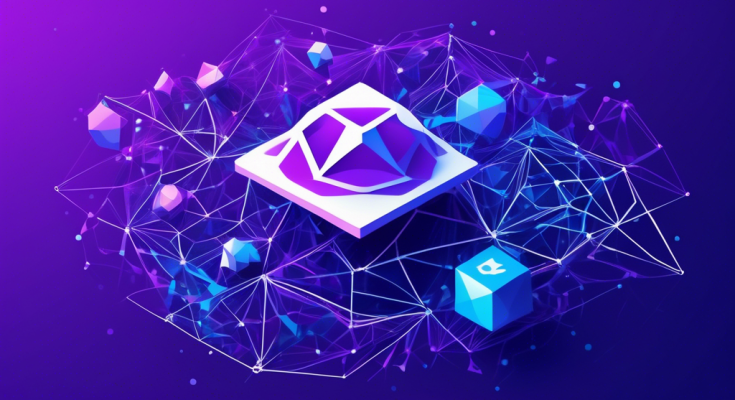What is Polygon Crypto? An In-Depth Introduction
Definition and Overview of Polygon Crypto
Polygon Crypto, often referred to simply as Polygon, is an innovative Layer 2 scaling solution for Ethereum, designed to improve the network’s transaction speed and reduce costs. Previously known as Matic Network, Polygon aims to solve some of the most pressing issues faced by Ethereum, such as high transaction fees and network congestion. By providing a framework for building interconnected blockchain networks, Polygon seeks to create an Internet of Blockchains where different blockchains can exchange information seamlessly.
Key Features and Unique Selling Points
Polygon distinguishes itself in the crowded cryptocurrency market through several key features and unique selling points. It offers a modular and flexible framework, allowing developers to create and connect Layer 2 chains, sidechains, and other independent blockchains. This flexibility ensures that different blockchain solutions can be tailored to meet specific application needs. Other significant features include its robust security protocols, high throughput, and increased transaction speeds, all of which contribute to a frictionless user experience.
How Polygon Stands Out in the Cryptocurrency Market
Polygon stands out in the cryptocurrency market by addressing the scalability and usability issues that plague many blockchain networks. Unlike other solutions that offer merely incremental improvements, Polygon provides a comprehensive platform that combines a variety of scaling techniques, such as Plasma chains, zk-Rollups, and Optimistic Rollups. This multi-faceted approach allows Polygon to offer scalable and efficient blockchain solutions while maintaining Ethereum’s robustness and security. Furthermore, Polygon’s growing ecosystem, which includes partnerships with prominent developers and businesses, highlights its increasing adoption and potential for long-term success.
What is Polygon Crypto? An In-Depth Introduction
Definition and Overview of Polygon Crypto
Polygon Crypto, often referred to simply as Polygon, is a protocol and a framework designed for building and connecting Ethereum-compatible blockchain networks. Originally launched as Matic Network in 2017, Polygon rebranded in early 2021 to reflect its expanded vision and capabilities. The core aim of Polygon Crypto is to address various limitations associated with the Ethereum blockchain, including high gas fees, limited scalability, and slow transaction speeds.
Polygon achieves this by providing an infrastructure that allows for the creation of interconnected blockchain networks. By leveraging layer-2 scaling solutions, Polygon significantly enhances the performance and efficiency of the Ethereum network, making it more accessible and usable for a broader range of applications and users.
Key Features and Unique Selling Points
Polygon Crypto differentiates itself in the crowded market of blockchain technologies through a variety of key features and unique selling points:
- Scalability: Polygon enhances the scalability of the Ethereum network by utilizing layer-2 scaling techniques, which offload transactions from the main Ethereum chain to more efficient secondary chains.
- Interoperability: One of Polygon’s standout features is its ability to connect various blockchain networks, enabling seamless interaction and data transfer between different systems. This makes it highly versatile and future-proof.
- Low Transaction Fees: By reducing the load on the main Ethereum chain, Polygon is able to offer significantly lower transaction fees, making it a more cost-effective option for both developers and users.
- Developer-Friendly: Polygon provides a rich set of tools and resources for developers, including a modular framework that allows for the easy deployment of custom blockchain networks tailored to specific needs and use cases.
- Security: Security remains a top priority for Polygon. The protocol employs robust security mechanisms, including the use of a decentralized network of validators and advanced cryptographic techniques, to ensure secure and trustworthy transactions.
How Polygon Stands Out in the Cryptocurrency Market
In the competitive landscape of blockchain technologies, Polygon Crypto has managed to carve out a distinctive niche due to several factors:
Comprehensive Solution for Ethereum’s Limitations: Unlike many other projects that address just one specific issue, Polygon offers a holistic solution that tackles multiple pain points of the Ethereum network, such as high fees, slow transaction speeds, and scalability constraints.
Strong Community and Ecosystem: Polygon boasts a rapidly growing community of developers, users, and partners. Its ecosystem includes a wide array of decentralized applications (dApps), decentralized finance (DeFi) platforms, and non-fungible token (NFT) marketplaces, all of which benefit from Polygon’s enhanced performance and lower costs.
High Profile Partnerships: Over time, Polygon has secured partnerships with several well-known projects and entities in the blockchain space. These partnerships not only bolster Polygon’s credibility but also expand its reach and applicability across various industries.
Future-Proof Architecture: The modular and flexible design of Polygon’s framework means it can adapt and evolve with changing technological needs and market demands. This future-proofing allows for continuous improvements and upgrades, ensuring long-term relevance and sustainability.
Community-Driven Governance: Polygon empowers its community by incorporating governance mechanisms that allow stakeholders to have a say in the protocol’s development and future direction. This democratic approach fosters a sense of ownership and engagement among users and developers.
In summary, Polygon Crypto is not just another blockchain solution; it is a comprehensive, scalable, and developer-friendly protocol poised to address some of the most pressing challenges facing the Ethereum network today. Its unique features, combined with robust security measures and a thriving ecosystem, make it a formidable player in the cryptocurrency market, with significant potential for future growth and adoption.
How Polygon Crypto Works: A Technical Breakdown
The Polygon Network: Architecture and Components
Polygon crypto, formerly known as Matic Network, operates as a layer-2 scaling solution for Ethereum. It aims to enhance the Ethereum blockchain’s performance by providing more efficient and cost-effective transactions. The architecture of the Polygon network consists of several components, each playing a crucial role in its functionality.
The primary component is the Polygon SDK, a modular and flexible framework supporting the creation and connection of multiple layer-2 solutions. This SDK allows developers to build various types of blockchain environments, catering to diverse project requirements. Moreover, Polygon utilizes sidechains, which run alongside the Ethereum mainchain, to process transactions more efficiently. Sidechains enable off-chain transaction execution while maintaining a secure link to the Ethereum mainchain.
Another vital component is the Plasma Chains, an integral part that leverages the Plasma framework to improve scalability by enabling faster and low-cost transactions. Plasma Chains allow the execution of smart contracts off the Ethereum mainchain, contributing significantly to Polygon’s scalability prowess. Additionally, Polygon introduces the concept of Polygon Bridge, which enables seamless interoperability between the Ethereum mainchain and other blockchains, ensuring a cohesive transaction experience.
Consensus Mechanisms and Security Protocols
Polygon crypto employs a combination of consensus mechanisms to ensure network security and transaction integrity. The primary consensus mechanism is Proof-of-Stake (PoS), where validators are responsible for verifying and validating transactions. These validators are chosen based on the number of Polygon tokens (MATIC) they hold and are willing to stake as collateral. This staking process ensures the validators have a vested interest in maintaining the network’s security and authenticity.
A key aspect of Polygon’s security protocol is the implementation of Plasma checkpoints, which provide a means to periodically record the state of the sidechain onto the Ethereum mainchain. These checkpoints act as a security layer, offering a snapshot of the sidechain’s status and enabling quick resolution in case of disputes or malicious activities. Plasma checkpoints ensure that even though transactions occur off-chain, they maintain a validated and secure link with Ethereum’s robust security infrastructure.
Additionally, Polygon incorporates a Layer-2 Rollup technology, including Optimistic Rollups and Zero-Knowledge (ZK) Rollups. These rollups further enhance security by bundling multiple transactions into a single, verifiable proof, reducing the load on the Ethereum mainchain while maintaining high fidelity and security.
Transaction Speed and Scalability Solutions Offered by Polygon
Polygon crypto addresses two of the most pressing issues plaguing the Ethereum blockchain: transaction speed and scalability. Ethereum, while renowned for its robustness, often struggles with slow transaction times and high gas fees, especially during periods of network congestion. Polygon circumvents these challenges through innovative scaling solutions.
One remarkable feature of Polygon is its ability to handle thousands of transactions per second (TPS). This is a significant leap from Ethereum’s current capabilities, where transaction speeds can range between 15-30 TPS in its base layer. This drastic improvement is facilitated by Polygon’s sidechains and the efficient utilization of rollup technologies. By offloading computations and transactions from the Ethereum mainchain to Polygon’s sidechains, the network significantly reduces transaction latency and congestion.
Furthermore, the synergy between Optimistic Rollups and ZK Rollups underpins much of Polygon’s scalability offering. Optimistic Rollups assume transactions are valid by default and only run computations to identify faults if necessary, thus speeding up transaction processing. On the other hand, ZK Rollups generate cryptographic proofs that verify transaction validity, ensuring security without the need for extensive on-chain computations.
Another innovative scalability solution is the use of Polygon Hermez, a zk-rollup based layer-2 scalability solution. Hermez optimizes scalability by grouping multiple transactions into a single batch and generating a zero-knowledge proof. This proof, once verified, ensures that the transactions within the batch are valid, dramatically improving transaction throughput.
In summary, Polygon crypto’s architectural components, consensus mechanisms, and advanced scalability solutions work in tandem to provide an efficient, secure, and scalable transaction environment. Its capacity to integrate seamlessly with Ethereum while mitigating common issues of speed and scalability renders Polygon a pivotal player in the cryptocurrency ecosystem. The ongoing developments and enhancements in Polygon’s technology indicate strong potential for future growth and adoption across diverse industry use cases.
Benefits and Use Cases of Polygon Crypto
Real-World Applications and Industry Adoption
Polygon Crypto has swiftly established itself as a vital player in the evolving blockchain landscape, offering an array of real-world applications that solve critical issues in various industries. One of the most prominent applications is in decentralized finance (DeFi). DeFi platforms are leveraging Polygon’s scalable solutions to create more efficient financial services such as lending, borrowing, and trading without the need for traditional intermediaries.
The gaming industry is another sector where Polygon Crypto is making significant strides. Polygon enables developers to build and deploy blockchain-based games with enhanced performance and lower transaction fees. This is particularly valuable in the growing market of non-fungible tokens (NFTs), where transaction speed and cost are crucial factors. By utilizing Polygon, game developers can provide players with a seamless experience, thus driving higher user engagement and retention.
Additionally, supply chain management is benefiting from Polygon’s technology. Blockchain provides transparency and traceability, which are crucial in supply chains. Polygon allows for more efficient data recording and retrieval processes, ensuring that all stakeholders have access to reliable and tamper-proof information. This not only enhances operational efficiency but also builds trust among participants.
Advantages for Developers and Businesses
Polygon Crypto offers numerous advantages for developers and businesses, making it an attractive option for those looking to harness blockchain technology. One of the primary benefits is its high scalability. Polygon’s Layer 2 solutions enable transactions to be processed off the main Ethereum chain, significantly reducing congestion and improving transaction speeds. This scalability is crucial for developers building applications that require fast and frequent transactions.
For businesses, the low transaction fees associated with Polygon are particularly appealing. Traditional blockchain networks like Ethereum can have high gas fees, making it cost-prohibitive for some business models. Polygon provides a more cost-effective solution, allowing businesses to operate more sustainably and affordably on the blockchain.
The interoperability of Polygon is another key advantage. Polygon is designed to work seamlessly with Ethereum and other blockchain networks, providing developers with the flexibility to integrate different technologies. This interoperability ensures that projects built on Polygon can communicate with a broader ecosystem, enhancing their functionality and reach.
Future Prospects and Potential Growth of Polygon Crypto
The future prospects of Polygon Crypto are promising, given its current trajectory and the growing adoption of blockchain technology across various industries. As more businesses and developers recognize the benefits of Polygon’s scalable solutions, its user base is expected to expand exponentially.
One of the significant areas of potential growth is in the decentralized web or Web 3.0. Polygon is well-positioned to support the infrastructure required for this new generation of internet, which leverages blockchain for enhanced security, privacy, and user ownership of data.
Moreover, Polygon’s commitment to continuous innovation is likely to drive its future growth. The platform is actively investing in research and development to enhance its technology and introduce new features. This dedication to innovation will help Polygon stay ahead of the curve and maintain its competitive edge in the dynamic blockchain landscape.
Collaboration with other blockchain projects is another avenue that could fuel Polygon’s growth. By partnering with complementary platforms and technologies, Polygon can create synergies that further enhance its value proposition for users.
Overall, the benefits and use cases of Polygon Crypto underscore its potential as a transformative technology in the blockchain space. From improving financial services to enabling more efficient supply chain management and driving the future of the decentralized web, Polygon is poised to make a significant impact on various industries. As it continues to evolve and expand, Polygon Crypto is likely to become an increasingly integral part of the blockchain ecosystem.
Conclusion
Polygon crypto represents a revolutionary advancement in the cryptocurrency landscape, offering a robust framework that enhances both scalability and usability. Through our exploration, we’ve detailed what makes Polygon Crypto unique, from its innovative architecture to its efficient transaction mechanisms. By leveraging the strengths of the Ethereum blockchain while addressing its scalability challenges, Polygon positions itself as a highly viable solution in the crypto space.
The platform’s technical infrastructure, including its consensus mechanisms and security protocols, underscores its commitment to providing a secure and efficient experience for its users. Polygon’s capacity to enhance transaction speed and scalability without compromising on security marks it as a standout player amongst its peers.
The benefits and real-world applications of Polygon Crypto are extensive, ranging from decentralized finance (DeFi) solutions to enterprise applications and beyond. Developers and businesses can tap into its resources to create scalable and user-friendly blockchain solutions, future-proofing their operations in an increasingly digital world.
Looking ahead, the potential for growth and further adoption of Polygon Crypto is substantial. As the blockchain and cryptocurrency ecosystems continue to evolve, Polygon’s adaptability and forward-thinking technological advancements position it as a cornerstone for future developments. In summary, Polygon crypto is not just an alternative; it’s a promising leap towards a more scalable and interconnected blockchain environment.
For anyone seeking to delve into the rapidly expanding world of blockchain technology, understanding Polygon Crypto is an essential step. Its blend of innovation, security, and practicality makes it a compelling choice for developers, businesses, and crypto enthusiasts alike.





